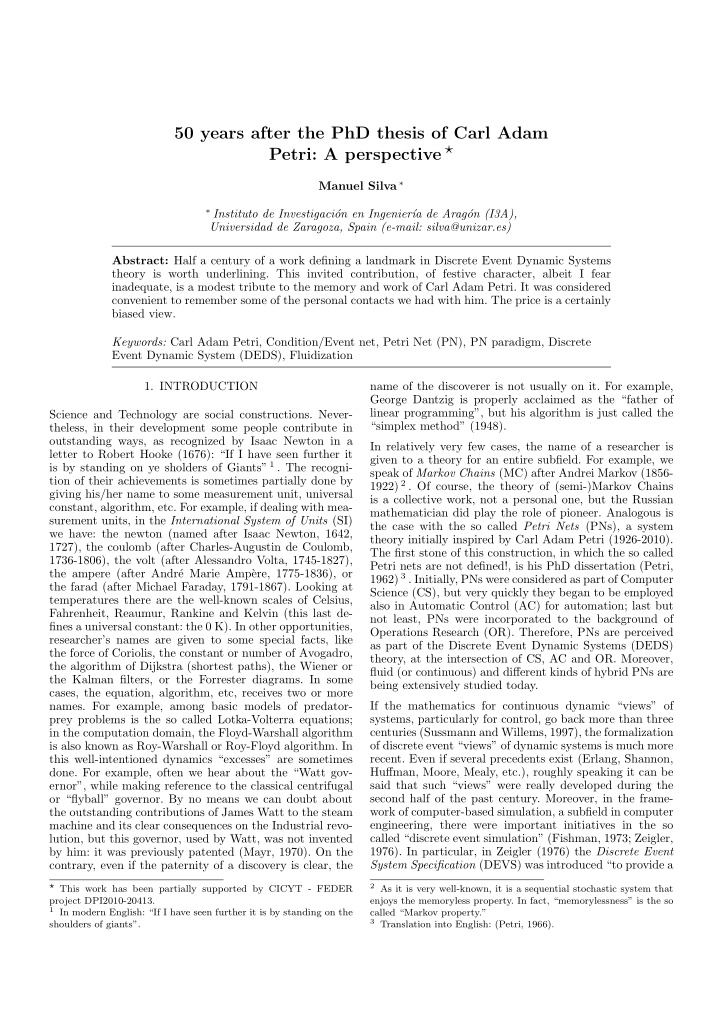



50 years after the PhD thesis of Carl Adam Petri: A perspective ⋆ Manuel Silva ∗ ∗ Instituto de Investigaci´ on en Ingenier´ ıa de Arag´ on (I3A), Universidad de Zaragoza, Spain (e-mail: silva@unizar.es) Abstract: Half a century of a work defining a landmark in Discrete Event Dynamic Systems theory is worth underlining. This invited contribution, of festive character, albeit I fear inadequate, is a modest tribute to the memory and work of Carl Adam Petri. It was considered convenient to remember some of the personal contacts we had with him. The price is a certainly biased view. Keywords: Carl Adam Petri, Condition/Event net, Petri Net (PN), PN paradigm, Discrete Event Dynamic System (DEDS), Fluidization 1. INTRODUCTION name of the discoverer is not usually on it. For example, George Dantzig is properly acclaimed as the “father of linear programming”, but his algorithm is just called the Science and Technology are social constructions. Never- “simplex method” (1948). theless, in their development some people contribute in outstanding ways, as recognized by Isaac Newton in a In relatively very few cases, the name of a researcher is letter to Robert Hooke (1676): “If I have seen further it given to a theory for an entire subfield. For example, we is by standing on ye sholders of Giants” 1 . The recogni- speak of Markov Chains (MC) after Andrei Markov (1856- tion of their achievements is sometimes partially done by 1922) 2 . Of course, the theory of (semi-)Markov Chains giving his/her name to some measurement unit, universal is a collective work, not a personal one, but the Russian constant, algorithm, etc. For example, if dealing with mea- mathematician did play the role of pioneer. Analogous is surement units, in the International System of Units (SI) the case with the so called Petri Nets (PNs), a system we have: the newton (named after Isaac Newton, 1642, theory initially inspired by Carl Adam Petri (1926-2010). 1727), the coulomb (after Charles-Augustin de Coulomb, The first stone of this construction, in which the so called 1736-1806), the volt (after Alessandro Volta, 1745-1827), Petri nets are not defined!, is his PhD dissertation (Petri, the ampere (after Andr´ e Marie Amp` ere, 1775-1836), or 1962) 3 . Initially, PNs were considered as part of Computer the farad (after Michael Faraday, 1791-1867). Looking at Science (CS), but very quickly they began to be employed temperatures there are the well-known scales of Celsius, also in Automatic Control (AC) for automation; last but Fahrenheit, Reaumur, Rankine and Kelvin (this last de- not least, PNs were incorporated to the background of fines a universal constant: the 0 K). In other opportunities, Operations Research (OR). Therefore, PNs are perceived researcher’s names are given to some special facts, like as part of the Discrete Event Dynamic Systems (DEDS) the force of Coriolis, the constant or number of Avogadro, theory, at the intersection of CS, AC and OR. Moreover, the algorithm of Dijkstra (shortest paths), the Wiener or fluid (or continuous) and different kinds of hybrid PNs are the Kalman filters, or the Forrester diagrams. In some being extensively studied today. cases, the equation, algorithm, etc, receives two or more names. For example, among basic models of predator- If the mathematics for continuous dynamic “views” of prey problems is the so called Lotka-Volterra equations; systems, particularly for control, go back more than three centuries (Sussmann and Willems, 1997), the formalization in the computation domain, the Floyd-Warshall algorithm of discrete event “views” of dynamic systems is much more is also known as Roy-Warshall or Roy-Floyd algorithm. In recent. Even if several precedents exist (Erlang, Shannon, this well-intentioned dynamics “excesses” are sometimes Huffman, Moore, Mealy, etc.), roughly speaking it can be done. For example, often we hear about the “Watt gov- said that such “views” were really developed during the ernor”, while making reference to the classical centrifugal second half of the past century. Moreover, in the frame- or “flyball” governor. By no means we can doubt about work of computer-based simulation, a subfield in computer the outstanding contributions of James Watt to the steam engineering, there were important initiatives in the so machine and its clear consequences on the Industrial revo- called “discrete event simulation” (Fishman, 1973; Zeigler, lution, but this governor, used by Watt, was not invented by him: it was previously patented (Mayr, 1970). On the 1976). In particular, in Zeigler (1976) the Discrete Event contrary, even if the paternity of a discovery is clear, the System Specification (DEVS) was introduced “to provide a ⋆ This work has been partially supported by CICYT - FEDER 2 As it is very well-known, it is a sequential stochastic system that project DPI2010-20413. enjoys the memoryless property. In fact, “memorylessness” is the so 1 In modern English: “If I have seen further it is by standing on the called “Markov property.” 3 Translation into English: (Petri, 1966). shoulders of giants”.
Recommend
More recommend